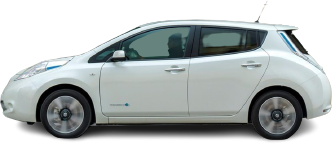EURO 1-phase 10A
- Socket specs
Socket specs
- 230 V, 10 A, 1-phase
- Socket output
Socket output
- 2.3 kW
- Charging 20-80%
Charging 20-80%
- 08 h 07 min (~18 km/h)


The Nissan Leaf 30 kWh is an all-electric front-wheel drive hatchback. It came out in 2015 replacing the older Nissan Leaf 24 kWh (2013). Nissan stopped making the 30 kWh in 2018 and replaced it with the Nissan Leaf 40 kWh.
The Nissan Leaf 30 kWh has a 30 kWh battery pack, allowing it to travel up to 180 km on a single charge. The car has an average efficiency of 15.6 kWh per 100 km (or 156 Wh/km) — ranked №538 out of 586 electric vehicles.
The Nissan Leaf 30 kWh can accelerate from 0 to 100 km/h in 11.5 seconds (ranked №482 out of 586 electric vehicles) and reach a top speed of 144 km/h.
The car’s powertrain delivers up to 80 kW (107 hp) of power and 254 Nm of torque.
The real-world range of the Nissan Leaf 30 kWh is 162–198 km (ranked №538 out of 586 electric vehicles) — depending on several factors, including:
It's important to remember that these are just estimates, and your actual range may vary. It's always best to factor in these various factors when planning your trip and be prepared for potential charging stops.
Plan your trips using the EV Navigation interactive map.
The Nissan Leaf 30 kWh in Europe is equipped with a CHAdeMO charging port. You can charge it conveniently at home using a standard outlet, or utilize any public AC charging station with the appropriate cable. However, the car's built-in charger (inverter) limits the maximum AC charging speed to 3.3 kW, which translates to roughly 19 km of range added per hour.
For faster charging, use DC fast-charging stations. The Nissan Leaf 30 kWh supports a maximum DC charging rate of 47 kW, but it's important to note that battery temperature and current charge level can affect the actual charging speed you'll experience.
To estimate charging time, rate, and cost, you can use our Charging calculator.
Here are the dimensions and weight for the Nissan Leaf 30 kWh:
Behind the rear seats of the Nissan Leaf 30 kWh, you'll find 370 litres of storage space (ranked №401 out of 586 electric vehicles).
Folding down the rear seats expands the total cargo capacity to 680 litres (ranked №433 out of 586 electric vehicles).
The car doesn’t have a “frunk” (front trunk).







